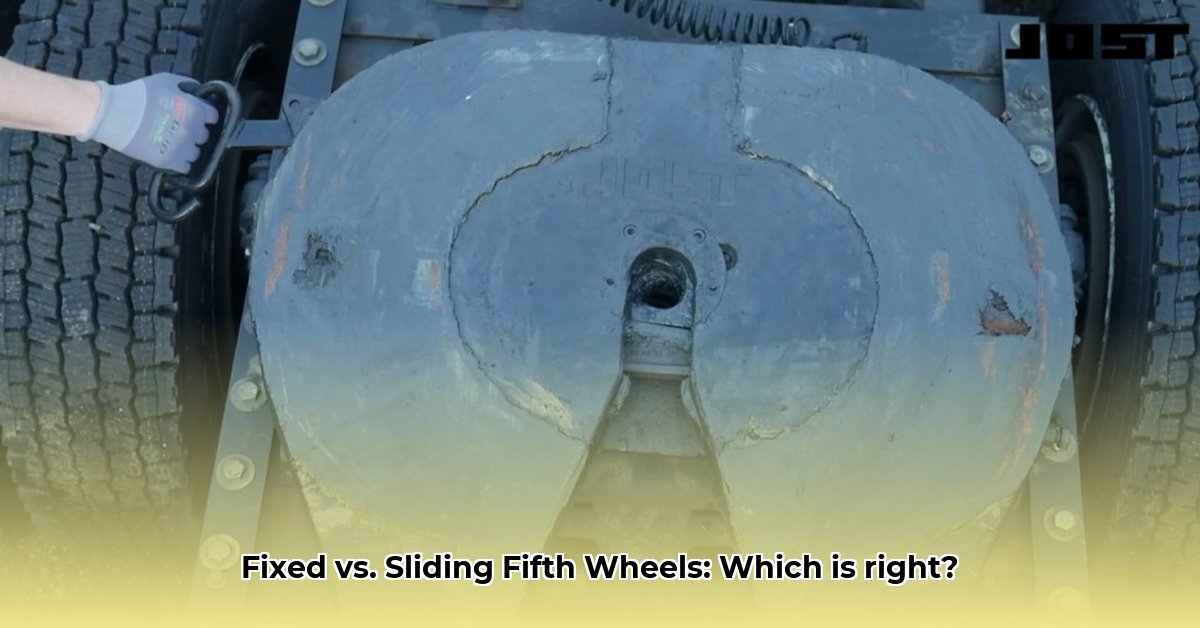
Making the Smart Choice for Your Fleet
Selecting the appropriate fifth wheel for your semi-truck is a critical decision impacting operational efficiency, payload capacity, and overall cost-effectiveness. This guide compares fixed and sliding fifth wheels, helping you choose the best option for your specific needs. Understanding the differences between these systems is crucial for maximizing your return on investment (ROI) and ensuring safe, compliant operation. For more information on heavy-duty towing, check out this helpful resource on 4WD tractors.
Understanding the Basics: A Simple Analogy
Think of connecting your trailer to your truck. A fixed fifth wheel is like a permanently attached, simple hitch; a sliding fifth wheel is a more sophisticated system allowing for trailer position adjustment. Both utilize a kingpin for connection, but their functionalities diverge significantly.
Fixed Fifth Wheels: The Straightforward Solution
Fixed fifth wheels prioritize simplicity and reliability. They feature fewer moving parts, minimizing maintenance complexities and repair costs. This makes them a cost-effective choice for operations with consistent cargo.
Pros:
- Simplicity and Reliability: Fewer moving parts translate to fewer potential points of failure, reducing maintenance and repair frequency.
- Lightweight Design: The lighter design increases your payload capacity, potentially maximizing your profits per haul.
- Lower Initial Cost: Fixed fifth wheels generally come with a lower purchase price compared to sliding units.
Cons:
- Limited Flexibility: The fixed connection point restricts adaptation to diverse cargo lengths and weights.
- Weight Distribution Challenges: Even weight distribution can be challenging, potentially causing uneven tire wear or stability issues. Do you frequently struggle with optimal weight balance?
Sliding Fifth Wheels: Flexibility and Control
Sliding fifth wheels provide adaptability, allowing for minor trailer repositioning. This feature offers superior control over weight distribution and enhances maneuverability in diverse situations.
Pros:
- Adaptability: Easily accommodates varied cargo lengths and weights, allowing for greater flexibility in haul types.
- Weight Distribution Optimization: Enables precise weight distribution across axles, improving stability and reducing the chances of overloading.
- Improved Maneuverability: Essential for navigating tight spaces like loading docks or city streets. Is tight space navigation a common challenge for your fleet?
Cons:
- Higher Initial Cost: Sliding fifth wheels are more expensive upfront than fixed units.
- Increased Complexity: More moving parts increase the potential for repairs and maintenance, increasing long-term costs.
- Potential for Increased Maintenance: Regular lubrication and inspection are crucial to prevent premature wear and failure.
Comparing Fixed and Sliding Fifth Wheels: A Summary
| Feature | Fixed Fifth Wheel | Sliding Fifth Wheel |
|---|---|---|
| Initial Cost | Lower | Higher |
| Maintenance | Simpler, less frequent | More complex, potentially more frequent |
| Weight | Lighter | Heavier |
| Flexibility | Limited | Greater |
| Payload Capacity | Potentially higher | Potentially lower (depending on weight distribution) |
| Maneuverability | Less maneuverable | More maneuverable |
Making the Right Decision: Key Questions to Ask
- What type of cargo do you haul? Consistent loads favor fixed fifth wheels; varied cargo necessitates sliding fifth wheels.
- How frequently do you approach weight limits? Sliding fifth wheels offer better weight distribution control, reducing the risk of overloading.
- What is your budget? Consider both initial investment and long-term maintenance expenses.
- What is your operating environment? Frequent tight-space navigation benefits from the improved maneuverability of sliding fifth wheels. Long-haul operations with consistent loads may be more suited to fixed fifth wheels.
The Final Verdict: Your Operational Needs Drive the Choice
Choosing between a fixed and sliding fifth wheel requires a thorough evaluation of your specific operational needs, budget, and typical cargo. There's no single "best" solution; the ideal choice aligns with your unique requirements. Careful consideration of these factors will enable you to make an informed decision for optimal efficiency and profitability. Remember to always consult with experienced trucking professionals for personalized recommendations.